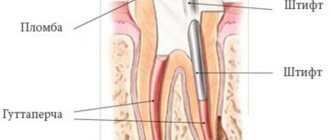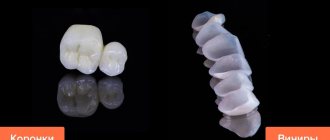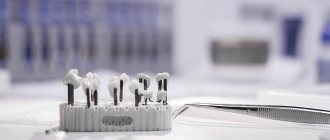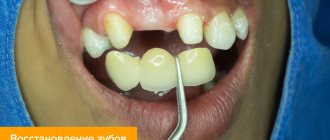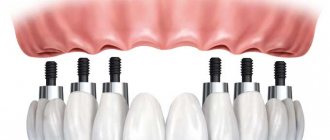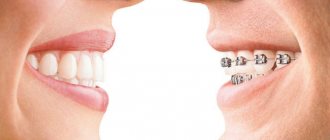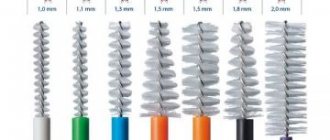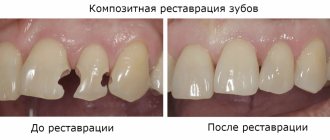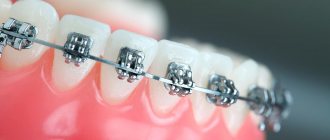Types For chewing teeth For front teeth Comparison How to choose a clinic?
Works Doctors When the need for dental prosthetics arises, the question arises - which crowns are best to install. Modern dentistry offers various options for dental crowns. They differ in material, purpose, and manufacturing technology. Each type has its pros and cons, each is recommended for certain indications.
Which dentures are better to put instead of chewing teeth - options, comparison, cost
Article navigation
- Functions of chewing teeth
- Prosthetic options
- — fixed dentures
- - removable dentures
- - conditionally removable
- Optimal methods of prosthetics
- The crown is destroyed, but the root is preserved
- One or more teeth are missing
- - bridges
- - removable structures
- - dentures on implants
- Installation
- How to care
- Price
Question for a specialist
Chewing teeth (premolars and molars) play a key role in the dental system and take on a greater load than the front ones. At the same time, their anatomy and location make care difficult. That is why they are susceptible to destruction, mainly as a result of injuries due to chewing stress and dental diseases. Prosthetics of chewing teeth involves the use of various orthopedic structures and materials, the choice of which depends on the degree and location of the damage, as well as the patient’s requests. Next, we will talk about how chewing teeth are prosthetized and which prosthesis is better if they are missing.
Single-stage implantation
Separately, it is worth mentioning about one-stage dental implantation in the chewing zone. If at a dentist's appointment you hear a disappointing verdict that a tooth needs to be removed, do not rush to the surgeon's office. Find out from your dentist if there are any indications for immediate implantation in your case.
This is a protocol that is minimally invasive. The problematic tooth is removed and an implant is immediately inserted into the fresh socket. There is no need to cut the mucosa and apply stitches. In addition, one-stage implantation saves time, since the patient does not need to wait for the wound to heal after removal so that classical implantation can be done.
Advantages of the method: minimal trauma among all implantation protocols, reliability, longevity of the result.
Disadvantages: not suitable for all patients. If the bone tissue under the diseased teeth is destroyed or thinned out, it will not be possible to place an implant at once.
Functions of chewing teeth and their characteristics
By chewing teeth of an adult we mean small chewing teeth - premolars ("four" and "five"), and large chewing teeth - molars ("six", "seven" and "eight"), which are located on the sides of each dentition. That is, both the lower and upper jaws have 10 chewing teeth, and in total there are 20 of them in the mouth - although there may be fewer of them if the “eights” have not erupted.
Molars and premolars perform the functions of a kind of “millstone”. Due to the protruding tubercles on their surface, they grind food so finely that it becomes suitable for further absorption by the body (and then enters the esophagus and stomach). Therefore, premolars and molars are very important for the normal functioning of the gastrointestinal tract and health in general.
BEST REMOVABLE DENTURE - 20,000 rub.
All manipulations for the manufacture, installation and fitting of the prosthesis, including impressions, are included.
Save RUB 10,000! >> Call now or request a call
Opening hours: 24 hours a day - seven days a week
Premolars and molars experience very heavy loads, which can exceed 75 kilograms per square centimeter. Therefore, nature itself intended that they have massive dimensions (otherwise they would simply break from the pressure). But the service life of these teeth is seriously reduced by the presence of caries in the fissures (these are grooves between the tubercles), which gradually turns into pulpitis. And treatment of pulpitis is often complicated by a large number of roots (there can be up to 4 of them) and poor treatment of root canals, which can also be curved and difficult to pass.
Damage to a metal crown
In some cases, a metal crown can cause harm:
- After its installation, galvanic syndrome may develop. This is caused by the use of several alloys to make the orthopedic structure. The combination of differently charged metals leads to the generation of galvanic current. A metallic taste, swelling and burning in the mouth, headaches, sleep disturbances, and malaise appear.
- A stamped crown is not made from individual impressions, so it is not suitable for fully recreating the functions of a living tooth.
- It does not fit tightly to the tooth, forming a gap between the walls into which food debris gets trapped. Therefore, healthy tissue can begin to rot underneath it.
- A one-piece prosthesis has high thermal conductivity. Therefore, if it was installed on a non-pulpless tooth, unpleasant sensations may occur when eating hot food.
Modern prosthetic options
What kind of prosthetics can a dentist offer if there are no chewing teeth? These can be different types of orthopedic structures - fixed, conditionally removable and classic removable dentures. Let us consider further their features for prosthetics of chewing teeth.
Fixed dentures
The most reliable method of prosthetics for the lower and upper chewing teeth are fixed dentures. Since they are fixed well, they do not fall out of the mouth, and their small size makes it easier to get used to and does not cause nausea or changes in the taste of food. Among the options for permanent prosthetics of chewing teeth, the following can be noted:
- dental inlays: these are micro-prostheses made of ceramic/zirconium dioxide, which are modern analogues of fillings. Microprostheses are used if part of the top of the tooth has broken off or it has been affected by caries (more than a quarter, but less than half) - if a large filling cannot be placed,
- stump inlays: they differ from the previous ones in that they cover not only the apex, but also the root, extending the life of the tooth without a nerve,
- dental crowns: used if the degree of damage to the crown has reached more than 50-60%, or if only the root remains,
- bridge prosthesis: this type of prosthetics is suitable in the absence of 1-3 chewing teeth. The bridge consists of several crowns, the outer ones are fixed on the ground supporting teeth, and the central ones mask the defect and rest against the gums. The downside is that due to the loss of just one tooth, two adjacent ones need to be ground down, even if they are alive and healthy,
- adhesive dental bridge: differs from the previous one in that there are no outermost hollow crowns for installation on supporting teeth, i.e. and no turning of supports is required. The prosthesis is attached to the dentition using special glue due to the lateral “wings”,
- permanent dentures on implants: for a single restoration these are dental crowns on implants, for the restoration of a large number of missing molars and premolars – bridges or segments. In this case, “living” supports are needed, and the structures are securely fixed only on implants, which make it possible to extend their service life by at least twice.
Zirconium dioxide crown on an implant for the whole 70,000 rubles.
OSSTEM implant (South Korea), individual zirconium abutment, gum former, impression taking.
Creation of a Prettau zirconium crown using 3D modeling technology. Consultation with 2 doctors: an orthopedist and an implantologist for free! Call now or request a call
Opening hours: 24 hours a day - seven days a week
Removable dentures
In the absence of several molars or premolars, the presence of terminal defects, during preparation for implantation or after it, removable dentures are often offered. These can be clasp1 designs - on hooks, on attachments or on telescopic crowns. And also dentures made of plastic or immediate dentures instead of 1-2 chewing teeth, acrylic, Acry-free, nylon, Quattro Ti, polyurethane.
Clasp ones have a metal base and are quite securely fixed in the oral cavity. Plastic ones are basically a cheaper option for prosthetics of chewing teeth (but also less reliable). Plastic dentures are attached to adjacent teeth using clasps (hooks), and can also additionally contain a large palatal bridge or massive artificial gum on the lower jaw.
Conditionally removable structures
Conditionally removable, as a rule, are installed with a completely toothless jaw, but an option is possible when it replaces segments and sectors. The essence of conditionally removable prosthetics is that the prosthesis is fixed on implants, but at the same time it can be removed independently if necessary (although it occurs very rarely), but it is better for the removal to be carried out by a dentist. This method differs from fixed prostheses on implants in the type and durability of the fastening - in conditionally removable ones, it becomes loose over time, and the prosthesis begins to shift. Less often, such dentures are fixed on 2-4 supporting teeth, of which only the roots remain - they are strengthened with special metal locks.
Modeling a solid crown
A more durable prosthetic option is to install a solid crown made of cobalt-chrome alloy. As the name implies, they are cast completely, and not in parts, like stamped ones. An undeniable advantage of a cast crown is the absence of solder joints, which makes it especially durable. It fits tightly to the ground tooth, preventing the cement from dissolving and reducing the risk of food getting under it. Wearing period is 15-20 years.
Modeling a solid crown includes several stages:
- Tooth preparation. From 0.3 to 0.5 mm of tissue is sanded off.
- Making impressions, including adjacent and opposing teeth.
- Creating a wax cap using the stretching method.
- Casting the prosthesis.
- Metal surface treatment. Fitting, finishing, polishing.
Types of solid crown
Nowadays, several types of solid crowns are installed in the dentist’s office:
- Without spraying, these are ordinary crowns of a metallic color.
- Sprayed. If the patient is not satisfied with the low level of aesthetics, at his request, the crowns can be coated with a coating that imitates gold.
- With lining. Crowns lined with ceramics are even more aesthetically pleasing. Their front part is covered with a ceramic lining. If you have just such a prosthesis installed, be careful when eating, as ceramics tend to chip.
- Combined. With combined prosthetics, some of the crowns are veneered with ceramics, and the rest, which are not visible when smiling, are installed without veneering.
What to do if the crown is destroyed but the root is preserved
In this situation, the only possible option is to install an artificial crown with fixation on its own root, which is first recommended to be strengthened with a core tab. You can choose metal-ceramic crowns on metal alloys (when a steel, cobalt-chrome or titanium cap is lined with ceramic mass). Pure ceramics or metal-plastic will not work, because... will break quickly under load.
However, the best option (and therefore the most expensive) would be crowns made of zirconium dioxide - they are durable, fit exactly onto the core inlay (which can also be zirconium dioxide), have very good aesthetics and an anatomically correct shape (due to the use of computerized equipment in the manufacture of crowns) .
Which crowns are best for front teeth?
For the front teeth, crowns with the highest aesthetic rating should be selected. They should not differ from the other elements of the front row. The load, of course, is not the same as on chewing teeth, but biting food with incisors implies a margin of safety.
- ceramic.
The amazing ability to absorb light rather than reflect it from the surface, porcelain's transparency makes the imitation of a natural tooth excellent. - zirconium.
They are on par with ceramic ones in aesthetics, but are more durable. For the front teeth, it is worth considering getting these crowns if you have the financial opportunity. - metal-ceramic.
This is the answer to the question of which crown to put on your front teeth inexpensively. In this case, it is necessary to take into account the possibility of cyanosis in the area of contact between the gums and the metal base of the prosthesis. To avoid this, a metal-ceramic crown with shoulder mass is installed. The tooth is ground a little more, with a ledge. And more area is covered with ceramics. To solve this problem, noble inert metal alloys can be used for the crown frame. All this increases the price of prosthetics.
Metal-ceramics can shine through the gums, which is undesirable for the front group of teeth
Comparison table for crowns made of different materials:
| Aesthetics | Strength | Life time | Price | Notes | |
| Dental metal (cobalt-chrome, etc.) | low | high | long | low | possible allergies, bluish gums |
| Noble metals (gold, etc.) | low | high | long | high | possible allergies, “blueness” of the gums (solved by using precious metals in the base) |
| Metal ceramics | above average | average | average | average | |
| Ceramics | high | average | average | high | |
| Zirconium dioxide | high | high | long | high | |
| Metal-plastic | average | low | short | low | for temporary purposes |
Expert of the article Alekperov Roman Borisovich Dentist-orthopedist, doctor of the first category
Work experience24 years
If one or more teeth are missing along with the root
Bridges – classic, adhesive or cantilever bridge
If 1-2, and in some cases even three chewing teeth are missing, then a permanent dental bridge can be used. True, you will have to sharply sharpen 2-3 adjacent teeth, since supports are needed to attach the bridge. It should also be remembered that at the edges of the defect at least healthy tooth roots should be preserved, which will become supporting elements. It is better to choose a structure made of zirconium dioxide, since the material allows you to create a long-lasting and durable dental bridge without compromising quality.
An adhesive bridge is usually not placed in the lateral parts of the jaw, because It peels off quickly under load. There is also a variant of a cantilever bridge, which can be placed even with end defects (if the outermost molar has been removed, for example), and its hollow crowns are “mounted” on supports that go only on one side. But this solution is also short-lived, because... provokes dislocation of the supports - and subsequently they have to be removed.
Removable orthopedic structures
If many chewing teeth are missing on both sides of the dentition at once, then the removable structure recommended is a clasp one, which has a strong metal base and does not sag under load, and also distributes chewing pressure well over the gums and jawbone. Such a prosthesis is attached using metal hooks, special clasps (attachments) or telescopic crowns. Moreover, the hooks can be noticeable from the outside.
Instead of the traditional clasp, you can use its metal-free analogue - Quattro Ti, but its service life is slightly shorter. Both types of structures are created with a thin palatal bridge, which is more comfortable than the massive palate of plate and acrylic ones. However, over time, discomfort from any removable appliances will still appear - due to changes in the bite, they will become a little loose, fit poorly to the gums, may fall out and even rub the mucous membranes.
Dentures on implants
Prosthetics installed on implants have virtually no disadvantages - and even the cost of such a solution, which seems high at first, completely pays for itself over time (which cannot be said about conventional removable and non-removable ones). Let us consider further the advantages of dentures on implants:
- restoration of any number of chewing teeth,
- the most reliable fixation,
- noticeable extension of the service life of prostheses - at least two times,
- absence of discomfort and quick adaptation,
- ideal appearance: the structures are small in size, and in some cases there may even be no artificial gum, so they look more natural. Prostheses for restoring chewing teeth in the upper jaw are created without the palate. In addition, dental crowns are made from the most aesthetic and durable materials (metal-ceramics and zirconium dioxide),
- precise fit to the gum: crowns on implants are fixed slightly under the gum, so their boundaries are completely invisible,
- the spaces between artificial crowns are also preserved, which again achieves maximum naturalness of the dentition.
That is why, with high demands on comfort, it is necessary to choose permanent fixed prostheses - crowns or dental bridges fixed on implants. They will last for decades and will become equivalent substitutes for your own lost teeth.
How to install metal crowns
Installation is carried out in two stages:
- First, the crown is placed temporarily so that the dentist can observe the tooth’s reaction.
- If the patient does not experience pain, at the next appointment it is removed, the temporary cement is cleaned and installed again, but using glass ionomer or zinc phosphate cement.
If after the first installation it turns out that it causes discomfort in the patient, it is removed and processed again.
A correctly manufactured and installed metal crown:
- Has a smooth, polished surface.
- Contacts the opposite and adjacent teeth.
- Imitates the anatomical shape of a real tooth.
- Fits tightly to the neck of the tooth.
- Immerses into the periodontal groove by 0.2 mm.
How to install
First, the prosthetic structure must be manufactured. To do this, the patient undergoes sanitation of the oral cavity, X-ray examination of the jaws, installation of implants (if required), and taking impressions of the dentition. Next, the production of the denture begins, which can take from 1-2 days to a month - it all depends on the workload of the dental laboratory. As for classic removable and non-removable products, the patient comes 1-2 more times to try on the model according to which the prosthesis will be made. If the crown or bridge will be fixed on implants, and precise computer equipment is used to make them, then fitting is not necessary.
Don't know what type of prosthetics to choose?
We will help in the selection, advise where to read more information and compare types of prosthetics.
Consultation with an orthopedic doctor in Moscow clinics is free! Call now or request a call
Working hours: from 9:00 to 21:00 - seven days a week
When the product is ready, it is installed on the patient (the method depends on the type of prosthesis) and recommendations for wearing and care are given.
How to properly care for orthopedic structures
Usually the dentist talks about the rules of care after prosthetics. The easiest way to care for fixed crowns and bridges (including those on implants) is to clean them twice a day with a soft or medium-hard brush and a paste without scratching particles. You should also visit the dentist 1-2 times a year for examination and prevention.
With removable structures it is more difficult - they must not only be cleaned with a brush with a special paste, but also constantly removed from the mouth for rinsing (usually after eating). They also need to be disinfected in a special solution once every 1-2 weeks. You will have to visit the clinic 3-4 times a year, because... The prosthesis will have to be adjusted and relined regularly.
Cost in Moscow and other cities
The price of a chewing tooth prosthesis depends on the amount of work and type of prosthetics. For example, if the root is intact, you need to install a stump tab and 1 crown - here the average cost of prosthetics will be 15 thousand rubles. If you need a bridge, then the cost of prosthetics is at least 25 thousand. A removable “butterfly” costs about 7,000 rubles, and the price of a clasp or “Quadrotti” will be at least 45 thousand. An inexpensive crown with an economy-class implant together cost about 30-35 thousand, and premium ones – from 80 thousand rubles.
1Naumovich S.A. Orthopedic dentistry. Prosthetics with removable plate and clasp dentures, 2009.
Author: Nepochatykh V.V. (Thank you for your help in writing the article and the information provided)
